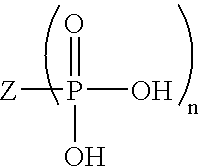Ophthalmic Compositions Comprising a Branched, Glycerol Monoalkyl Compound and a Fatty Acid Monoester
a technology of glycerol monoalkyl compound and fatty acid monoester, which is applied in the direction of lens cleaning composition, detergent compounding agent, etc., can solve the problems of increasing the tendency of solutions to foam, increasing production costs, and increasing the difficulty of product handling for consumers, so as to enhance the biocidal effect of an aqueous ophthalmic composition
- Summary
- Abstract
- Description
- Claims
- Application Information
AI Technical Summary
Benefits of technology
Problems solved by technology
Method used
Image
Examples
example 1
[0074]Prototype multi-purpose lens care compositions containing varying amounts of octoxyglycerin as a foam inhibiting agent are prepared. Such formulations differ only in the amount of octoxyglycerin used therein. The basic prototype formulation for the lens care product is shown in Table 1.
example 2
[0075]The ability of varying small amounts of 3-[(2-ethylhexyl)oxy]-1,2-propanediol to inhibit foam formation and improve foam draining performance of the prototype lens care composition of Example I is demonstrated by means of a foam height evaluation test. In such a test, 50 mL of the solution being tested is placed in a 100 mL graduated cylinder (2.6 cm in diameter). The foam height is measured after 10 seconds of vigorous shaking of the cylinder containing the test solution. Foam height after 30 minutes of standing is also measured to evaluate foam draining propensity of the test solutions. Foam height testing results are shown in Table 2.
[0076]The Table 2 data indicate that when used in amounts over 0.05 ppm, the 3-[(2-ethylhexyl)oxy]-1,2-propanediol material can provide effective control of foaming in multi-purpose lens care products which contain over 3.0 wt % of foaming surfactants such as Pluronic® F127 and Tetronic® 1107.
TABLE 1Formulation of a Multi-Purpose Lens Care Solu...
example 3
[0080]PHMB (Polyamino propyl Biguanide Hydrochloride, 2 g, 0.0011 mole,) and HMBDA (1,6-bis(cyanoguanadino)hexane, 0.3 g, 0.0012 mole were mixed and ground together, then placed in a 100 mL round bottom flask. Concentrated Hydrochloric acid (100 μL) was then added to the PHMB / HMBDA. The mixture was slowly heated to 100° C. until all the liquid was driven off. The heat was then increased to 150° C. to 160° C. and held for 4 hours. The reaction mixture was cooled to room temperature providing 1.32 g of the crystalline material PHMB-CG*.
TABLE 4Biocidal results of multi-purpose formulations containingEHOPD and decanoylglycerol.TimeLog ReductionFormulationpointSa1Pa2Sm3Ca4Fs51a30 min1.4>4.7>4.70.21.0 4 hour1.5>4.7>4.70.52.01b30 min1.6>4.71.80.82.7 4 hour3.6>4.71.8>4.8>4.61c30 min1.9>4.7>4.72.8>4.6 4 hour>4.9>4.7>4.7>4.8>4.61Staphylococcus aureus (ATCC 6538)2Pseudomonas aeruginosa (ATCC 9027)3Serratia marcescens (ATCC 13880)4Candida albicans (ATCC 10231)5Fusarium Solani (ATCC 36031)
PUM
 Login to View More
Login to View More Abstract
Description
Claims
Application Information
 Login to View More
Login to View More - R&D
- Intellectual Property
- Life Sciences
- Materials
- Tech Scout
- Unparalleled Data Quality
- Higher Quality Content
- 60% Fewer Hallucinations
Browse by: Latest US Patents, China's latest patents, Technical Efficacy Thesaurus, Application Domain, Technology Topic, Popular Technical Reports.
© 2025 PatSnap. All rights reserved.Legal|Privacy policy|Modern Slavery Act Transparency Statement|Sitemap|About US| Contact US: help@patsnap.com



